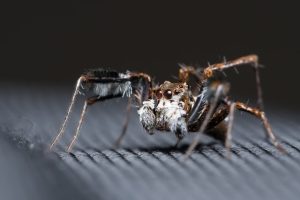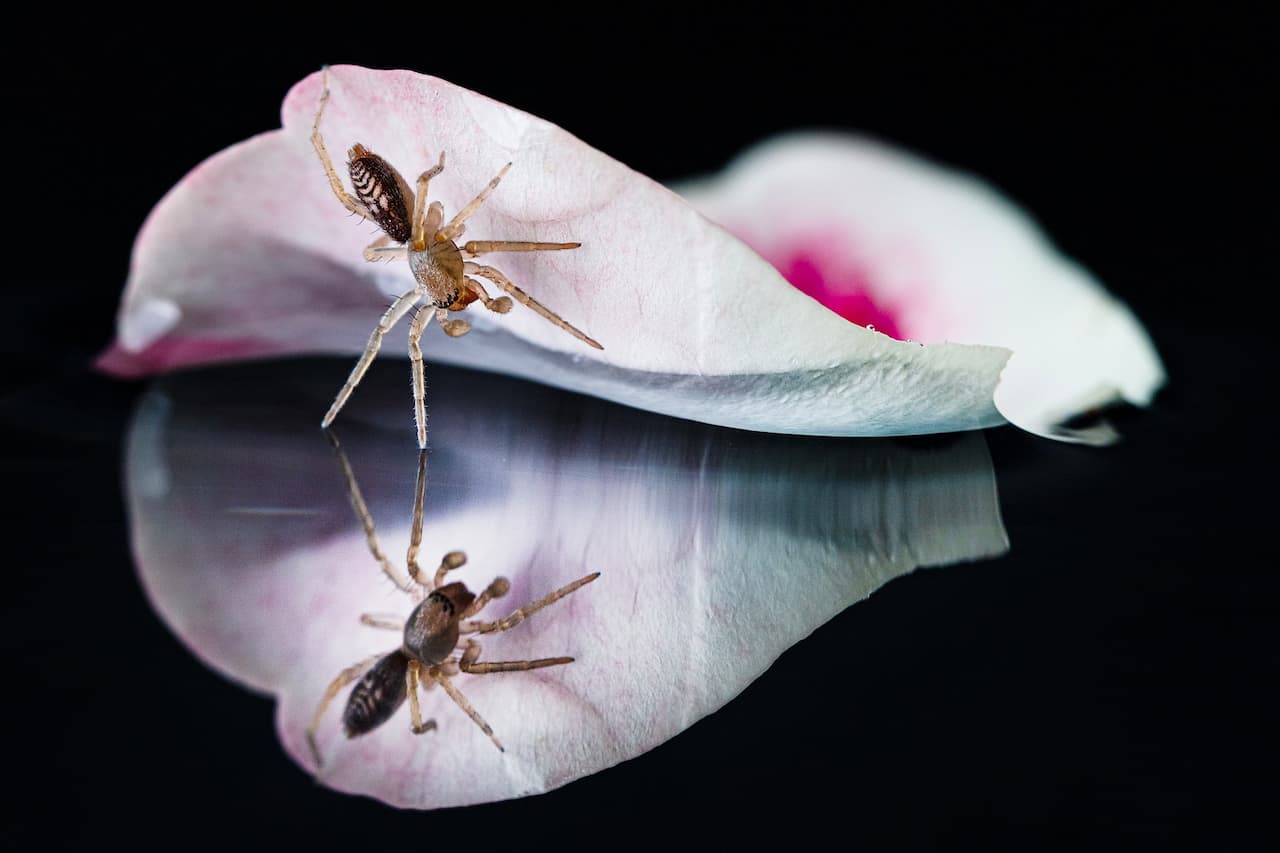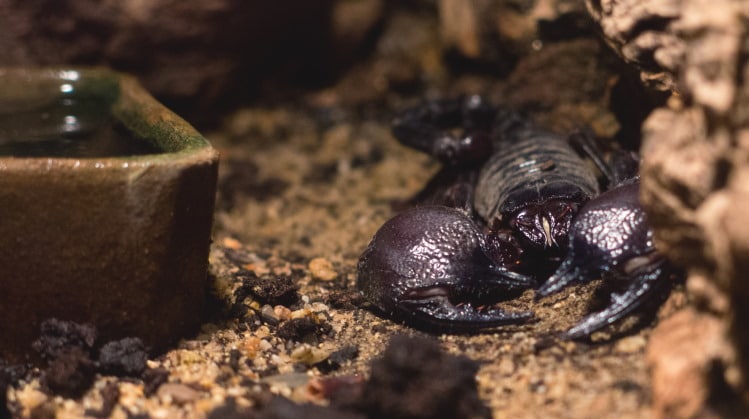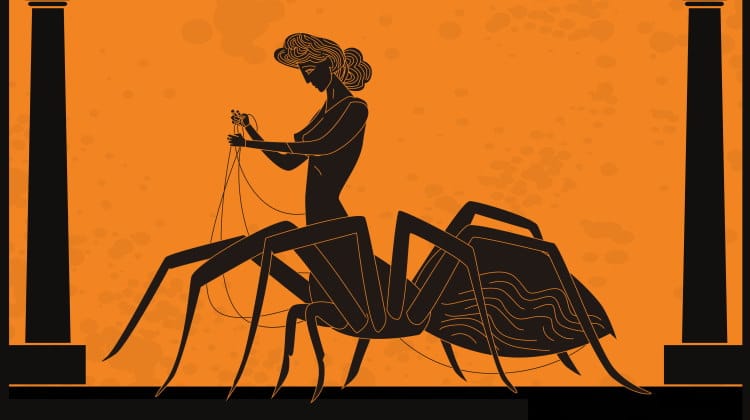Jumping Spiders
Species Of Jumping Spiders (Portia)
Jumping spiders of the genus Portia are a fascinating group of spiders found throughout many tropical and sub-tropical regions

around the world. There are over 20 described species in this genus, all displaying incredible hunting behaviors and strategies.
Portia spiders do not build webs to catch prey but instead actively hunt by stealthy stalking and leaping onto their prey. They have excellent vision and can plan routes to sneak up on prey. Here, we will explore some of the many Portia species found around the globe.
Portia Africana
Portia africana is a jumping spider found in west and central Africa as well as Ethiopia. Adults range from 5 to 9 mm in body length and are generally brown or grey in color. They exhibit sexual dimorphism, with males being smaller and paler than females.
- africana inhabits forests and woodlands where it hunts by sneaking up on prey slowly. It has been observed capturing a wide variety of insects as well as other spiders.
Interestingly, this species practices cannibalism, with females sometimes preying on smaller males. The females produce an egg sac attached to vegetation and guard it until the spiderlings emerge.
Portia albimana
First described in 1900, Portia albimana is distributed across India, Sri Lanka, China, Myanmar, and Vietnam. These spiders are medium-sized, reaching 6-9 mm, with a brownish body bearing white spotted markings.
- albimana lives in the tangled branches of forest vegetation. It slowly stalks insect prey such as flies, caterpillars, and beetles. However, it prefers other spiders and is known to invade the webs of orb-weaver spiders to prey on the residents.
It gently plucks and shakes the resident spider’s web to mimic trapped prey. When the resident approaches, it attacks.
Females produce an egg sac attached to leaves and guard the eggs until they hatch. The spiderlings then disperse via ballooning on silk threads.
Portia assamensis
First described in 1978, Portia assamensis ranges from northeastern India to Malaysia. Adults reach about 5 mm in body length and are pale brown in color with faint stripes on the abdomen.
These jumping spiders inhabit forests and prey on a variety of insects. However, they specialize in invading the webs of other spiders to capture the residents as prey. P. assamensis gently plucks the web and then waits for the resident to approach before attacking.
If the resident does not approach, they will pluck the web more vigorously or send out aggressive vibrations. Females lay their eggs inside a rolled-up leaf secured with silk. The mother stands guard over the egg cocoon until the young emerge.
Portia bawang
Portia bawang is a newly described species found in the Wawang mountains of China’s Hainan province. These small jumping spiders reach about 2.5-3.5 mm in body length.
They have an orangish-brown abdomen with white patches at the front and back. Their head region is dark brown.
This species inhabits forested mountain slopes between 300-1400 m elevation. They hunt insects and other small prey in the vegetation, sometimes entering the webs of other spiders. The females lay their eggs inside curled leaves.
Portia crassipalpis
Portia crassipalpis is found from the Indian subcontinent to the Philippines and parts of Southeast Asia. These medium-sized jumping spiders are around 5-7 mm long with a grayish-brown abdomen bearing whitish spots or bands on the top.
- crassipalpis lives in forests and preys on various insects. However, they prefer to invade the webs of other spiders to capture the residents. The Portia spiders will gently pluck and shake the web in clever tactics to lure the resident out before swiftly ambushing.
Females produce an egg sac attached to bark or leaves and stand guard over the eggs until they hatch. The young then disperse by ballooning away on silk threads.
Portia erlangping
Portia erlangping is a species found only in the Erlangping National Forest Park in Sichuan, China. These spiders reach about 5 mm in body length and are pale brownish-grey in color with some faint striping on the abdomen.
This Portia species inhabits forests between 1300-1700 m elevation. They hunt by stealthily stalking smaller insects and spiders, sometimes invading the webs of other spiders to capture the residents. These spiders inhabit the branches and leaves of trees and shrubs.
Reproduction consists of the female laying an egg sac attached to vegetation, which she guards closely until the young emerge. More research is still needed on this Chinese endemic species.
Portia fajing
Portia fajing is another Chinese species, named after Mt. Fajing which is found in Hainan Province. These small jumping spiders are around 3 mm in body length with greyish-brown abdomens marked by white patches at the front and rear.
This tropical forest inhabitant lives in the branches of trees and shrubs. It slowly stalks insect prey but prefers hunting other spiders by invading their webs. The female lays her eggs in a curled-up leaf secured with silk and stands guard over the cocoon until spiderlings emerge.
Portia fimbriata
Portia fimbriata is a widely distributed species found from Africa to Asia and Australia. Adults are medium-sized, 5-9 mm long, with grey to brown abdomens marked by white bands, spots, or stripes.
These spiders inhabit forests and woodlands, where they hunt primarily by invading the webs of other spiders. P. fimbriata plucks the resident’s web to mimic prey caught in it, then strikes when the resident approaches to investigate. The Portia captures insects, too, but prefers spider prey.
Females lay eggs in a silken cocoon inside a rolled-up leaf or crevice and guard the egg sac. After emerging, the young spiders balloon away on silk threads to disperse.
Portia heteroidea
Portia heteroidea is a little-studied species found in Sulawesi, Indonesia. These small jumping spiders are approximately 3 mm in body length and light brown in color. They occupy the dense tangles of vegetation in tropical forests.
Like others in its genus, P. heteroidea is believed to be an araneophagic (spider-eating) specialist. It invades the webs of other spiders and employs clever predatory tactics to capture the resident spider. However, more research is still needed on this species’ biology.
Reproduction consists of the female laying an egg cocoon within a rolled-up leaf. She stands watch over the eggs until spiderlings emerge. The young then balloon away on silk to disperse.
Portia hoggi
Portia hoggi is endemic to Sri Lanka, where it inhabits dense forest and jungle environments. Reaching approximately 7 mm long, these spiders are pale brown with faint stripes on the abdomen.
- hoggi hunts by stealthily stalking insects but prefers to invade the webs of orb-weaver spiders. It gently plucks the resident spider’s web to mimic prey caught in it, then ambushes the resident when it approaches to investigate.
Females produce an egg sac attached to vegetation, which they guard devotedly. After emerging from the eggs, the spiderlings balloon away on silk threads to disperse and find new territory.
Portia jianfeng
This Chinese species is named after Mt. Jianfeng, which is found in Hainan Province. Portia jianfeng grows to around 5 mm long and has a brownish body marked by white bands on the abdomen. It inhabits tropical forests.
These spiders hunt mainly by invading the webs of orb-weaving spiders, which construct circular web traps. P. jianfeng gently plucks the web, and when the resident spider approaches, it swiftly ambushes. The Portia rarely goes after insects.
Reproduction involves the female constructing an egg sac made of silk, which she attaches to leaves or twigs. She guards the egg sac devotedly until the young spiders emerge. The spiderlings then disperse by ballooning away.
Portia labiata
Portia labiata is a fascinating species found in India and Sri Lanka throughout Southeast Asia. These medium-sized jumping spiders reach 5-7 mm in length and are brown with faint striping on their abdomens.
Found in forests and jungles, P. labiata primarily hunts other spiders. It slowly stalks its spider prey before pouncing and delivering a deadly bite.
- labiata also invades the webs of orb-weaving spiders, where it plucks the web to simulate trapped prey before ambushing the resident. This species occasionally eats insects, too.
Females lay eggs within a rolled-up leaf secured with silk and stand guard over the egg case until it hatches. The young spiders then disperse by ballooning away.
Portia orientalis
Portia orientalis ranges from northeast India to Singapore and parts of Indonesia. Adults reach approximately 9 mm in body length and are brownish-grey in color with faint stripes on their abdomens.
These spiders inhabit forests where they hunt insects like flies and moths by stealthily stalking them. However, they seem to prefer invading the webs of orb-weaving spiders.
- orientalis gently plucks the web and then ambushes the resident spider when it approaches to investigate.
Females produce an egg sac attached to vegetation, which they guard closely until spiderlings emerge. The young spiders then disperse via ballooning.
Portia quei
This recently discovered species is named after Mt. Quei where it is found in China’s Hainan Province. Portia quei is a small spider just over 3 mm long. It has an orange-brown abdomen marked by white patches at the front and back.
- quei inhabits tropical forest vegetation on the mountain slopes. It slowly stalks insect prey but seems specialized at invading the webs of other spiders to prey on the residents. Further research is still needed to better understand this species.
Reproduction involves the female laying her eggs inside a rolled-up leaf secured with silk. She guards the egg cocoon devotedly until spiderlings emerge and balloon away.
Portia schultzi
Portia schultzi is found across much of sub-Saharan Africa in forest and savanna habitats. Adults reach approximately 7-9 mm long and have brownish bodies marked by white flecks or thin bands on the abdomen.
These spiders hunt mostly by invading the circular webs of orb-weaving spiders. P. schultzi gently plucks the web to simulate trapped prey, then strikes when the resident approaches to investigate. This clever tactic allows them to capture web-building spiders.
Females attach their egg sacs to vegetation, often in a rolled-up leaf, and stand guard until the young emerge. The spiderlings then balloon away on silk threads to disperse.
Portia songi
This species from China is named after Mt. Song where it was first found in Hainan Province. Portia songi reaches about 4 mm in body length and has a brown abdomen marked by white patches at the front and rear.
- songi inhabits tropical forest vegetation in the mountain ranges. It slowly stalks and captures insect prey, but seems to prefer invading the webs of other spiders to prey on the residents. Further studies are needed on this species’ biology and behavior.
Reproduction consists of the female laying her eggs inside a rolled-up leaf, which she guards until the spiderlings emerge. The young spiders then disperse by ballooning away.
Portia strandi
Portia strandi is endemic to the island of Sri Lanka, where it is found in forested areas. Adults reach approximately 5-6 mm in body length and are light brown in color with faint bands visible on the abdomen.
This species lives among the tangled branches of vegetation, where it hunts insects like flies, moths, and beetles.
However, P. strandi seems to prefer invading the webs of orb-weaver spiders to prey on the residents. After plucking the web, it ambushes the resident spider when it comes to investigate.
Females guard their egg sacs, which are laid inside curled-up leaves until the young emerge. The spiderlings then balloon away on silk.
Portia taiwanica
As its name suggests, this species is endemic to the island of Taiwan. Portia taiwanica inhabits forests and woodlands where it grows to around 5 mm in body length. These spiders are pale brown with faint stripes visible on the abdomen.
- taiwanica hunts various insects, especially moths and flies. It uses slow, stealthy stalking tactics. This species also invades the webs of orb-weaver spiders, where it plucks the web to simulate trapped prey before ambushing the resident spider.
Females lay eggs within a rolled-up leaf secured with silk and stand guard over the egg case until spiderlings emerge. The young spiders then disperse by ballooning.
Portia wui
This jumping spider was first discovered in the Wuzhishan Mountains of Hainan Province, China, and named Portia wui after the collector. It reaches approximately 4 mm in body length and has a brown abdomen marked by white patches at the front and rear.
- wui inhabits tropical forests in the mountain ranges. It hunts insects but seems specialized at invading the webs of other spiders to capture the residents as prey. Very little is still known about the biology of this newer species.
Reproduction consists of the female laying her eggs inside a rolled-up leaf, which she guards devotedly until the spiderlings hatch. The young spiders then balloon away on silk.
Portia xishan
Portia xishan is named after the region of Xishan in Kunming, China, where it was first found. These small jumping spiders reach just 3-4 mm in body length. They have greyish-brown abdomens patterned with white flecks and patches.
This species inhabits forests and dense vegetation on mountain slopes. It hunts insects but seems to prefer invading the webs of other spiders to prey on the residents. P. xishan gently plucks the orb-weaver’s web to simulate trapped prey before ambushing.
The female lays an egg sac attached to leaves or twigs, which she stands guard over until the young emerge. The spiderlings then balloon away to disperse.
Portia zhaoi
The most recently discovered species, Portia zhaoi is known from a single female specimen collected in Taiwan. This spider measured approximately 5 mm in body length and had a pale brown abdomen marked by faint stripes.
Little is known about P. zhaoi since it was just described in 2022. It likely inhabits forest environments where it hunts insects and other small prey.
This species may also invade the webs of orb-weaver spiders like others in its genus. More specimens and studies are needed to better understand this Taiwanese Portia.
Reproduction is presumed to involve the female guarding an egg sac laid inside a curled-up leaf until spiderlings emerge. But more research is needed to confirm.
Conclusion
The genus Portia represents some of the most intelligent and impressive jumping spider species within an already exceptional family.
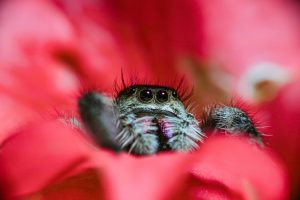
Their sensory capabilities, adaptable hunting behaviors, sneakiness, and situational problem-solving seem almost “cerebral” compared to other arachnids.
Continued research will likely uncover even more complex cognitive abilities and predatory strategies used by Portia spiders to hunt a range of prey in diverse habitats.
These fascinating jumping spiders showcase that invertebrates, like spiders, can possess surprisingly advanced behaviors and cognition comparable in some ways to mammals and birds.
Portia spiders provide an intriguing example of how evolution shapes specialized predators. Their skills show intelligence is not limited to animals with large brains.

